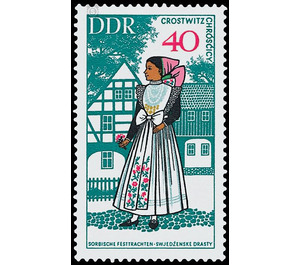National costumes - Germany / German Democratic Republic 1968 - 40 Pfennig
Theme: Architecture
| Country | Germany / German Democratic Republic |
| Issue Date | 1968 |
| Face Value | 40.00 |
| Color | green |
| Perforation | K 14 |
| Printing Type | Photogravure |
| Stamp Type | Postage stamp |
| Item Type | Stamp |
| Chronological Issue Number | 1097 |
| Chronological Chapter | GER-DDR |
| SID | 71933 |
| In 15 Wishlists | |
National costumes in the German Democratic Republic, 3rd edition The Ministry of Posts and Telecommunications of the German Democratic Republic publishes four multicolored commemorative stamps depicting Sorbian festive costumes. The stamps and the first day cover envelope contain the text in German and Sorbian. 20 years law for the protection of the rights of the Sorbian population With the smashing of the Hitler fascism also the Sorbian people found after centuries of social and national servitude for the first time in their homeland under the rule of the working class their true homeland. An eloquent testimony is the "Law for the Conservation of the Sorbian Population" passed by the Saxon State Parliament on March 23, 1948 at the suggestion of the Socialist Unity Party of Germany, whose 20th Anniversary German and Sorbs together in March of this year in more than 400 ceremonies and celebrations be worthy. With this document, the party of the working class and the state organs created for the first time in German history the legal basis for the enforcement of the Marxist-Leninist nationality policy, in the result of which the Sorbian national minority today occupies an equal position in all areas of social life in the GDR , A new socialist relationship has emerged between Germans and Sorbs. In the power organs of our state, begun from the People's Chamber to the municipal council, about 2,200 Sorbian deputies work and in the permanent commissions and active of these popular representations are more 4,000 Sorbs active. The Sorbian Institute for Teacher Training trained about 1,700 teachers and educators for the bilingual area of Lusatia. Nearly 900 Sorbian high school graduates completed the two Sorbian extended secondary schools. 30,000 students participated in the schools of the bilingual circles of the districts of Dresden and Cottbus on Sorbian lessons. The State Ensemble for Sorbian Folk Culture contributed 2,300 performances to 2.8 million visitors and the VEB Domowina-Verlag with 1,200 Sorbian publications to the development and dissemination of the treasures of Sorbian culture in our republic and abroad. The Sorbian professional and lay artists, together with the German cultural artists at the II Festival of Sorbian Culture, which also takes place on the occasion of the 20th anniversary of the adoption of the aforementioned law from May 18 to 26, 1968 in Bautzen, a balance of their artistic work and the socialist community of Germans and Sorbs as a contribution to the socialist national culture of our republic in front of 70,000 visitors. This II. Festival of the Sorbian culture is under the slogan: "All our strength for the all-round strengthening and consolidation of the sovereign German Democratic Republic - the socialist fatherland of all Sorbian and German citizens!". A specific element of valuable and genuine folk culture as well as the diverse folk life of the Sorbs are the Sorbian folk costumes still to be found daily in the four costal islands of Lusatia - between Bautzen and Kamenz, around Hoyerswerda, in the parish of Schleife and around Cottbus and in the Spreewald. The Ministry of Posts and Telecommunications of the German Democratic Republic issues a series of special stamps with Sorbian festive costumes as a contribution to nationality policy on the occasion of these holidays. She chose the costumes of the bridesmaid from Bluno, Hoyerswerde, (value 0.10 M), a bow (0.20 M), from the area of Bautzen-Kamenz (value 0.40 M) and the costume of the single godmother the Spreewald (value 0.50 M). These stamps are intended to help document the autonomous and equal development of the Sorbian national minority in the GDR under state support.


